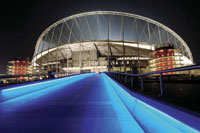
QATAR expects tourism to contribute $525 million to its gross domestic product (GDP) in 2006. Planned investments for 2006 involve $800 million or 10.4 per cent of the projected total investment planned by Qatar.
These targets are line with an ambitious tourism master plans planned by the Qatari leadership and articulated through Akbar Al Baker, chairman of Qatar Tourism Authority (QTA) and chief executive of Qatar Airways, represents significant investment in facilities and infrastructure to position Qatar as a leading high-quality international destination. For a country rich in cultural and natural resources, its tourism and aviation sectors are integral to the diversification of one of the world’s fastest growing economies and the dynamic development of Qatar for employment and investment opportunities.
In 2005, tourism numbers to Qatar grew substantially to reach more than 600,000 arrivals and the country is targeting an estimated 1.4 million inbound tourists by 2010.
With an estimated projected growth in the tourism sector between 2007 and 2016 of 4.1 per cent per annum, the incremental development is controlled and focused. Tourism is increasingly perceived as a key economic activity but the strategic plans are for the enrichment of travel experiences through sustainable development projects.
Qatar’s tourism ambitions as a destination of choice will be placed in the international spotlight by its hosting of the 15th Asian Games in December 2006 under the auspices of Doha Asian Games Organising Committee (DAGOC).
The Games, which will see athletes from a record 45 countries compete for sporting excellence in 39 different sports, will act as a catalyst through the massive infrastructural development that has been taking shape, enabling Qatar to host major sporting events all year round. The branding of the world event through the official mascot, Orry the oryx, is increasingly visible not only on the livery of some Qatar Airways aircraft and around the Qatar cityscape but internationally.
Thirty sports facilities will accommodate the athletes and 14 multi-purpose stadia have been built or refurbished. The completion of the Qatar Sports City combined with the visionary Aspire Academy, will nurture the best young sporting talents from the Middle East and internationally.
Importantly, QTA sees robust regulation as a vital aspect of building a quality destination as it spearheads the development of various leisure facilities and a sustainable tourism infrastructure.
Implicit in the tourism vision is the creation of an appropriate welcoming and friendly environment for quality tourism and QTA is tasked with developing and coordinating major tourism events in Qatar as well as supporting various events both nationwide and internationally.
The tourism challenge with the substantial investments pledged or planned is for a range of prestigious tourist and real estate projects including hotels, lifestyle resorts, cultural and sports projects, together with airline and aviation-related infrastructure projects that will be the prime delivery channel for tourists.
The visitor profile includes business travellers and quality leisure tourists, the MICE (meetings, incentives, conferences and exhibitions) sector, medical and sports tourism focusing on high yield and the stopover market. With the current average of 1.5 nights stay, QTA wants to increase the average stays to three to four nights by 2010 by creating a high-end destination and is decidedly not seeking mass-market tourism with cultural tourism implicit in the master planning.
Hotel capacity is growing exponentially. According to QTA there were almost 3,000 four- and five-star rooms in 2005 but the arrival of the Pearl Qatar, Millenium, Shangri-La hotels and other construction projects coming on stream by 2007 there will be almost 8,000 rooms available as well as beach resorts, marinas, shopping and enhanced recreation facilities. Later this year, construction begins for the $5 billion Lusail development, a 200,000 person residential and commercial centre 35km north of the Ritz-Carlton.
The creation of luxury lifestyle cities such as The Pearl where first occupancy is planned for 2007 also includes four marinas and three hotels. Qatar’s first international real estate development, The Pearl offers international investors freehold and residential rights.
Significantly investments in cultural facilities includes Qatar’s National Library, the five-storey Museum of Islamic Arts, and the Qatar Photographic Museum. Plans to conserve the country’s historic forts are progressing under the auspices of the National Council for Culture, Arts and Heritage.
The current Doha International Airport continues to expand its facilities to keep pace with demand whilst the $5 billion New Doha International Airport (NDIA), a new international gateway to Qatar, is set to open 2008/9. The planned capacity for the first phase is 12 million passengers a year rising to an annual capacity of 50 million passengers when fully developed.
